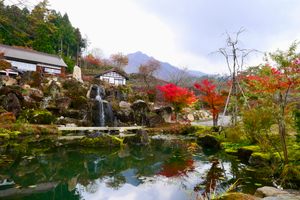Kankōji Temple in Minamiuonuma, Japan
Beautiful scenery, tranquil waterfalls, zen gardens, and ema prayer plaques aren’t the only reasons people visit this Buddhist temple. Kankōji Temple’s most famous element is salty, a little bit sweet, and kept in a jar. It also protected some of this temple’s most invaluable religious texts in 1578—and brings good fortune to this day. People from all over flock to Kankōji Temple for a lick of its homemade miso paste. The paste is thick and salty with slight notes of sweetness. Though it has a unique flavor, its history and spiritual benefits are its biggest draws. The original temple grounds were set on fire during 1578’s Otate War, destroying buildings and their contents. But 600 scrolls of the Great Prajnaparamita Sutra were saved from the fires as monks had stored the scriptures in barrels of homemade miso paste. The miso paste and barrels protected the texts from the fire, allowing the temple to rebuild after the blaze. Visitors can still have a taste of the legendary temple-made miso paste that had protected the texts. It is available in the temple’s main building where it’s scooped from a communal jar. Take-home jars of the miso are also available for purchase. It’s believed that sampling the miso brings luck and blessings.


Beautiful scenery, tranquil waterfalls, zen gardens, and ema prayer plaques aren’t the only reasons people visit this Buddhist temple. Kankōji Temple’s most famous element is salty, a little bit sweet, and kept in a jar. It also protected some of this temple’s most invaluable religious texts in 1578—and brings good fortune to this day.
People from all over flock to Kankōji Temple for a lick of its homemade miso paste. The paste is thick and salty with slight notes of sweetness. Though it has a unique flavor, its history and spiritual benefits are its biggest draws.
The original temple grounds were set on fire during 1578’s Otate War, destroying buildings and their contents. But 600 scrolls of the Great Prajnaparamita Sutra were saved from the fires as monks had stored the scriptures in barrels of homemade miso paste. The miso paste and barrels protected the texts from the fire, allowing the temple to rebuild after the blaze.
Visitors can still have a taste of the legendary temple-made miso paste that had protected the texts. It is available in the temple’s main building where it’s scooped from a communal jar. Take-home jars of the miso are also available for purchase. It’s believed that sampling the miso brings luck and blessings.


































































-Baldur’s-Gate-3-The-Final-Patch---An-Animated-Short-00-03-43.png?width=1920&height=1920&fit=bounds&quality=70&format=jpg&auto=webp#)






























































































































































































